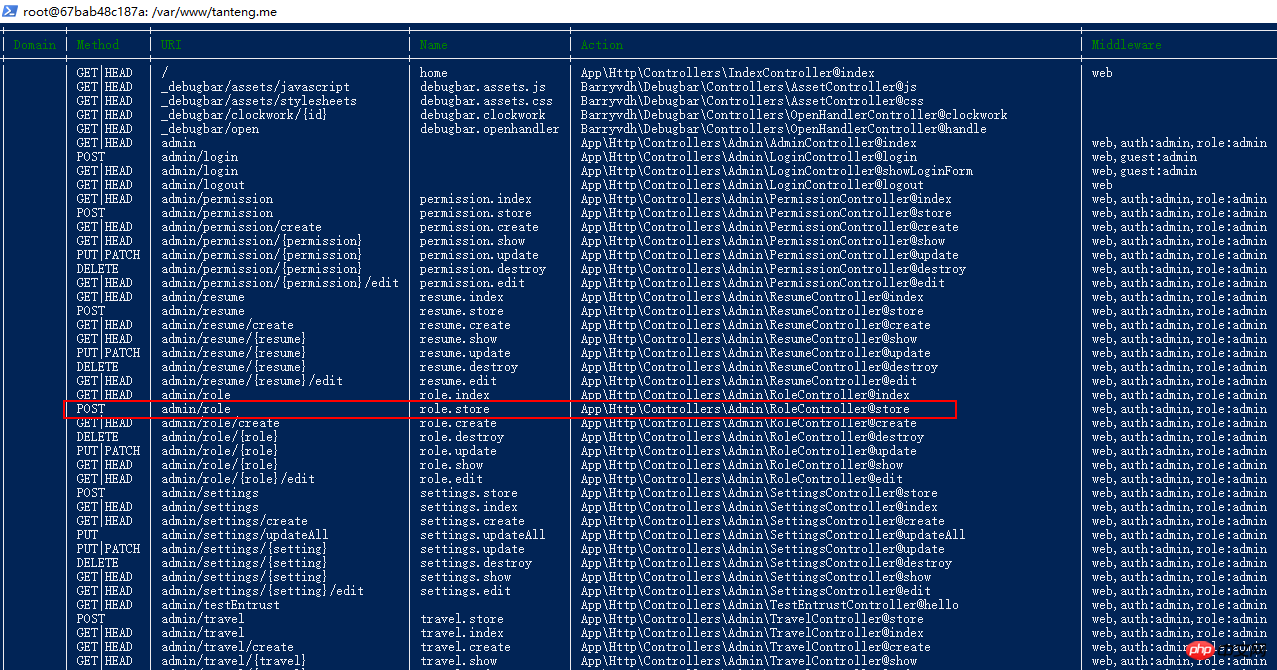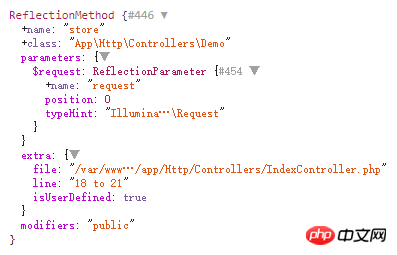 Backend Development
Backend Development
 PHP Tutorial
PHP Tutorial
 Parse Laravel dependency injection related content through source code
Parse Laravel dependency injection related content through source code
Parse Laravel dependency injection related content through source code
This article mainly introduces you to the relevant information on how to parse Laravel's dependency injection through source code. The article introduces it in great detail through sample code. It has certain reference learning value for everyone's study or work. Friends who need it can follow Let’s learn together with the editor.
Preface
As we all know, there are countless PHP frameworks. In recent years, a framework known for its elegance has gradually been known by domestic PHPers. , and started using it, but one obvious shortcoming of larave is that its documentation content is pitiful.
This article will give you a detailed introduction to Laravel dependency injection and share it for your reference and study. I won’t say much below, let’s take a look at the detailed introduction.
In the constructor or member method of Laravel's controller, dependency injection can be used through type constraints, such as:
public function store(Request $request)
{
//TODO
}Here, the $request parameter uses type constraints. Request is a class:\Illuminate\Http\Request, which means that the parameter must be this class or a subclass.
This article analyzes the source code of Laravel to see why Request can be used directly without passing in an instance in the method? It’s just that the framework automatically instantiates and passes parameters for us.
1. Route definition
Looking from the source, such a route is defined in the route definition file:
Route::resource('/role', 'Admin\RoleController');
This is a resource-based route. Laravel will automatically generate routing entries for additions, deletions, modifications and queries.

The store method at the beginning of this article is a controller method. The Action defined by the route visible in the figure is also: App\Http\Controllers\Admin\RoleController@store
Routing method analysis
Find the controller and method according to the routing definition, and execute the specific method in the dispatch method.
(File: vendor/laravel/framework/src/Illuminate/Routing/ControllerDispatcher.php)
public function dispatch(Route $route, $controller, $method)
{
$parameters = $this->resolveClassMethodDependencies(
$route->parametersWithoutNulls(), $controller, $method
);
if (method_exists($controller, 'callAction')) {
return $controller->callAction($method, $parameters);
}
return $controller->{$method}(...array_values($parameters));
}First resolveClassMethodDependencies method, "as the name suggests ” is to obtain the dependent object based on the method parameters of the class, and then call the class method and inject the object parameters.
If there are multiple dependent objects, they will be parsed out by foreach in turn and injected as parameters.
Code for obtaining dependent object examples:
protected function resolveClassMethodDependencies(array $parameters, $instance, $method)
{
if (! method_exists($instance, $method)) {
return $parameters;
}
return $this->resolveMethodDependencies(
$parameters, new ReflectionMethod($instance, $method)
);
}The key point here is the use of PHP reflection. Pay attention to the RelectionMethod method, which obtains the class Method parameter list, you can know the parameter type constraints, parameter names, etc.
The $instance parameter here is the RoleController controller class, and the $method parameter is the method name store.
2. Example of obtaining dependent objects
After obtaining the constraint type of the dependent object from the method parameters, you can instantiate the dependent object.
protected function transformDependency(ReflectionParameter $parameter, $parameters)
{
$class = $parameter->getClass();
// If the parameter has a type-hinted class, we will check to see if it is already in
// the list of parameters. If it is we will just skip it as it is probably a model
// binding and we do not want to mess with those; otherwise, we resolve it here.
if ($class && ! $this->alreadyInParameters($class->name, $parameters)) {
return $parameter->isDefaultValueAvailable()
? $parameter->getDefaultValue()
: $this->container->make($class->name);
}
}Get the object from the container based on the class name. The process of binding the object instance is first defined in the service provider.
Then pass the instantiated object into the store method, and you can use the dependent object.
3. About PHP reflection
Give an example of using ReflectionMethod.
class Demo
{
private $request;
public function store(Request $request)
{
}
}Print out the content of new ReflectionMethod(Demo::class, 'store') as shown in the figure:

You can get the parameter list of this method, the constraint type of the parameter, such as typeHint, Illuminate\Http\Request.
According to the class name, you can get the instance initially bound through the service provider from the container. .
Summary
Articles you may be interested in:
php data structure Examples of sequential linked lists and linked linear lists
Detailed explanation based on the difference between using commas and dots for echo in PHP
Example of php implementing statistical algorithm for counting the number of 1's in binary
The above is the detailed content of Parse Laravel dependency injection related content through source code. For more information, please follow other related articles on the PHP Chinese website!

Hot AI Tools

Undresser.AI Undress
AI-powered app for creating realistic nude photos

AI Clothes Remover
Online AI tool for removing clothes from photos.

Undress AI Tool
Undress images for free

Clothoff.io
AI clothes remover

Video Face Swap
Swap faces in any video effortlessly with our completely free AI face swap tool!

Hot Article

Hot Tools

Notepad++7.3.1
Easy-to-use and free code editor

SublimeText3 Chinese version
Chinese version, very easy to use

Zend Studio 13.0.1
Powerful PHP integrated development environment

Dreamweaver CS6
Visual web development tools

SublimeText3 Mac version
God-level code editing software (SublimeText3)

Hot Topics
 1664
1664
 14
14
 1423
1423
 52
52
 1317
1317
 25
25
 1268
1268
 29
29
 1246
1246
 24
24
 Laravel Introduction Example
Apr 18, 2025 pm 12:45 PM
Laravel Introduction Example
Apr 18, 2025 pm 12:45 PM
Laravel is a PHP framework for easy building of web applications. It provides a range of powerful features including: Installation: Install the Laravel CLI globally with Composer and create applications in the project directory. Routing: Define the relationship between the URL and the handler in routes/web.php. View: Create a view in resources/views to render the application's interface. Database Integration: Provides out-of-the-box integration with databases such as MySQL and uses migration to create and modify tables. Model and Controller: The model represents the database entity and the controller processes HTTP requests.
 Solve caching issues in Craft CMS: Using wiejeben/craft-laravel-mix plug-in
Apr 18, 2025 am 09:24 AM
Solve caching issues in Craft CMS: Using wiejeben/craft-laravel-mix plug-in
Apr 18, 2025 am 09:24 AM
When developing websites using CraftCMS, you often encounter resource file caching problems, especially when you frequently update CSS and JavaScript files, old versions of files may still be cached by the browser, causing users to not see the latest changes in time. This problem not only affects the user experience, but also increases the difficulty of development and debugging. Recently, I encountered similar troubles in my project, and after some exploration, I found the plugin wiejeben/craft-laravel-mix, which perfectly solved my caching problem.
 How to learn Laravel How to learn Laravel for free
Apr 18, 2025 pm 12:51 PM
How to learn Laravel How to learn Laravel for free
Apr 18, 2025 pm 12:51 PM
Want to learn the Laravel framework, but suffer from no resources or economic pressure? This article provides you with free learning of Laravel, teaching you how to use resources such as online platforms, documents and community forums to lay a solid foundation for your PHP development journey from getting started to master.
 Laravel user login function
Apr 18, 2025 pm 12:48 PM
Laravel user login function
Apr 18, 2025 pm 12:48 PM
Laravel provides a comprehensive Auth framework for implementing user login functions, including: Defining user models (Eloquent model), creating login forms (Blade template engine), writing login controllers (inheriting Auth\LoginController), verifying login requests (Auth::attempt) Redirecting after login is successful (redirect) considering security factors: hash passwords, anti-CSRF protection, rate limiting and security headers. In addition, the Auth framework also provides functions such as resetting passwords, registering and verifying emails. For details, please refer to the Laravel documentation: https://laravel.com/doc
 Laravel framework installation method
Apr 18, 2025 pm 12:54 PM
Laravel framework installation method
Apr 18, 2025 pm 12:54 PM
Article summary: This article provides detailed step-by-step instructions to guide readers on how to easily install the Laravel framework. Laravel is a powerful PHP framework that speeds up the development process of web applications. This tutorial covers the installation process from system requirements to configuring databases and setting up routing. By following these steps, readers can quickly and efficiently lay a solid foundation for their Laravel project.
 How to view the version number of laravel? How to view the version number of laravel
Apr 18, 2025 pm 01:00 PM
How to view the version number of laravel? How to view the version number of laravel
Apr 18, 2025 pm 01:00 PM
The Laravel framework has built-in methods to easily view its version number to meet the different needs of developers. This article will explore these methods, including using the Composer command line tool, accessing .env files, or obtaining version information through PHP code. These methods are essential for maintaining and managing versioning of Laravel applications.
 What versions of laravel are there? How to choose the version of laravel for beginners
Apr 18, 2025 pm 01:03 PM
What versions of laravel are there? How to choose the version of laravel for beginners
Apr 18, 2025 pm 01:03 PM
In the Laravel framework version selection guide for beginners, this article dives into the version differences of Laravel, designed to assist beginners in making informed choices among many versions. We will focus on the key features of each release, compare their pros and cons, and provide useful advice to help beginners choose the most suitable version of Laravel based on their skill level and project requirements. For beginners, choosing a suitable version of Laravel is crucial because it can significantly impact their learning curve and overall development experience.
 The difference between laravel and thinkphp
Apr 18, 2025 pm 01:09 PM
The difference between laravel and thinkphp
Apr 18, 2025 pm 01:09 PM
Laravel and ThinkPHP are both popular PHP frameworks and have their own advantages and disadvantages in development. This article will compare the two in depth, highlighting their architecture, features, and performance differences to help developers make informed choices based on their specific project needs.



